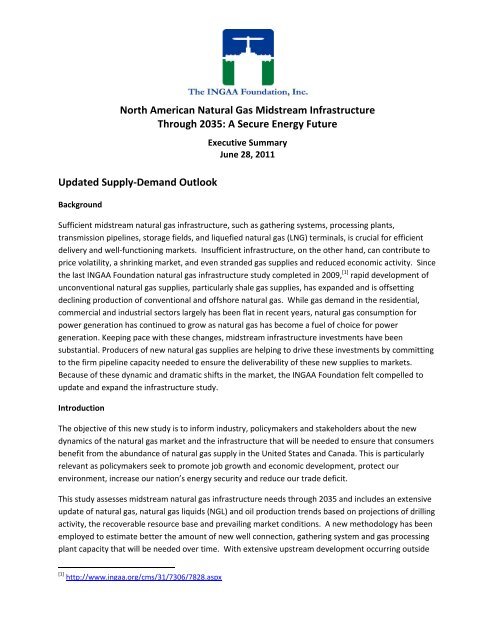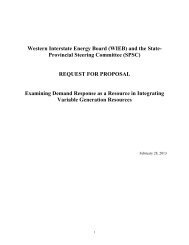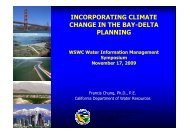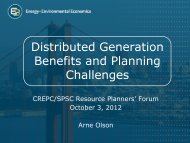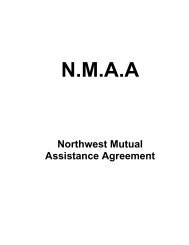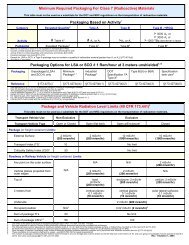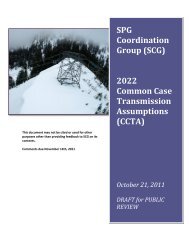North American Natural Gas Midstream Infrastructure Through 2035 ...
North American Natural Gas Midstream Infrastructure Through 2035 ...
North American Natural Gas Midstream Infrastructure Through 2035 ...
Create successful ePaper yourself
Turn your PDF publications into a flip-book with our unique Google optimized e-Paper software.
<strong>North</strong> <strong>American</strong> <strong>Natural</strong> <strong>Gas</strong> <strong>Midstream</strong> <strong>Infrastructure</strong><br />
<strong>Through</strong> <strong>2035</strong>: A Secure Energy Future<br />
Updated Supply‐Demand Outlook<br />
Background<br />
Executive Summary<br />
June 28, 2011<br />
Sufficient midstream natural gas infrastructure, such as gathering systems, processing plants,<br />
transmission pipelines, storage fields, and liquefied natural gas (LNG) terminals, is crucial for efficient<br />
delivery and well‐functioning markets. Insufficient infrastructure, on the other hand, can contribute to<br />
price volatility, a shrinking market, and even stranded gas supplies and reduced economic activity. Since<br />
the last INGAA Foundation natural gas infrastructure study completed in 2009, [1] rapid development of<br />
unconventional natural gas supplies, particularly shale gas supplies, has expanded and is offsetting<br />
declining production of conventional and offshore natural gas. While gas demand in the residential,<br />
commercial and industrial sectors largely has been flat in recent years, natural gas consumption for<br />
power generation has continued to grow as natural gas has become a fuel of choice for power<br />
generation. Keeping pace with these changes, midstream infrastructure investments have been<br />
substantial. Producers of new natural gas supplies are helping to drive these investments by committing<br />
to the firm pipeline capacity needed to ensure the deliverability of these new supplies to markets.<br />
Because of these dynamic and dramatic shifts in the market, the INGAA Foundation felt compelled to<br />
update and expand the infrastructure study.<br />
Introduction<br />
The objective of this new study is to inform industry, policymakers and stakeholders about the new<br />
dynamics of the natural gas market and the infrastructure that will be needed to ensure that consumers<br />
benefit from the abundance of natural gas supply in the United States and Canada. This is particularly<br />
relevant as policymakers seek to promote job growth and economic development, protect our<br />
environment, increase our nation’s energy security and reduce our trade deficit.<br />
This study assesses midstream natural gas infrastructure needs through <strong>2035</strong> and includes an extensive<br />
update of natural gas, natural gas liquids (NGL) and oil production trends based on projections of drilling<br />
activity, the recoverable resource base and prevailing market conditions. A new methodology has been<br />
employed to estimate better the amount of new well connection, gathering system and gas processing<br />
plant capacity that will be needed over time. With extensive upstream development occurring outside<br />
[1] http://www.ingaa.org/cms/31/7306/7828.aspx
traditional, conventional‐gas supply regions that generally are well served by existing pipelines, new<br />
midstream natural gas infrastructure represents a critical link that will benefit both natural gas<br />
producers and consumers. In addition, because the ability of natural gas supply to reach its potential<br />
will be affected by the development of natural gas liquids infrastructure and by the associated natural<br />
gas produced in connection with oil, this study includes a robust analysis of the amount of NGL and oil<br />
pipeline infrastructure that will be needed.<br />
Study results are driven by projected increases in U.S. and Canadian gas supply, as well as <strong>North</strong><br />
<strong>American</strong> demand growth, particularly in the power‐generation sector. <strong>Natural</strong> gas imports in the form<br />
of LNG, which in previous projections were viewed as a marginal supply source, have been displaced by<br />
even more robust domestic gas and NGL production growth in this updated study.<br />
Brief Summary of the <strong>Gas</strong> Market Outlook<br />
The April 2011 ICF reference case applied in this study projects real gas prices that rise from $4 to<br />
between $6 and $7 per MMBtu (2010$) by 2021 and through the end of the study period. This price<br />
level is sufficiently high to encourage substantial gas supply development, but not high enough to limit<br />
market growth significantly. Under the reference case gas price scenario, both gas supply and demand<br />
are expected to increase significantly over time, creating a positive environment for new natural gas<br />
midstream infrastructure.<br />
Economic, demand<br />
assumptions for the<br />
reference case: U.S.<br />
population grows at an<br />
average rate of about one<br />
percent per year. U.S.<br />
Gross Domestic Product<br />
(GDP) is assumed to grow at<br />
an average 2.8 percent per<br />
year, while electric load is<br />
assumed to grow at an<br />
average 1.3 percent per<br />
year. Oil prices average<br />
about $80 per barrel in real<br />
terms. Temperatures<br />
consistent with average<br />
conditions during the past 30 years.<br />
Resource/supply and study assumptions: Current U.S. and Canadian gas production originates from<br />
over 300 trillion cubic feet of proven gas reserves. The <strong>North</strong> <strong>American</strong> natural gas resource base is<br />
estimated to total almost 4,000 trillion cubic feet when adding unproved resources to discovered‐but‐<br />
2
undeveloped gas resource. That amount can supply U.S. and Canadian gas markets for about 150 years<br />
at current consumption levels. The study assumes gas supply development will continue at recently<br />
observed activity levels, and that there will be no new significant or special production restrictions. The<br />
projection also assumes no significant hurricane disruptions to natural gas supply. The supply outlook<br />
presented below is generally a market‐balancing view. In other words, the abundant resource base is<br />
balanced with demand to determine the volume that is produced or supplied.<br />
Construction of new pipelines and other midstream infrastructure assumed in the projection: Nearterm<br />
midstream infrastructure development is assumed to include existing project announcements.<br />
Unplanned projects are included in the projection when the market signals need of capacity. It is<br />
assumed that these projects are built without significant delays in permitting and construction. In this<br />
report, natural gas gathering and processing infrastructure projects are included. The upstream sector<br />
builds gathering and gas processing infrastructure as needed to support supply development. This<br />
infrastructure typically is financed as part of upstream project development. Projections for oil and<br />
natural gas liquids infrastructure have been included because gas is often co‐produced with these<br />
hydrocarbons. Arctic projects (specifically Alaska and Mackenzie Valley gas pipelines) are not included<br />
in the projection because market prices do not support such development. Net LNG exports occur only<br />
from Western Canada and there are no net LNG exports from elsewhere in the U.S. and Canada.<br />
<strong>Natural</strong> <strong>Gas</strong> Demand Results<br />
<strong>Natural</strong> gas consumption in the<br />
U.S. and Canada is projected to<br />
increase by an average 1.6<br />
percent per year through <strong>2035</strong>.<br />
Total natural gas use across all<br />
sectors is projected to rise to<br />
about 110 Bcfd in <strong>2035</strong>.<br />
Incremental demand growth<br />
between 2010 and <strong>2035</strong> is 35<br />
Bcfd, of which 26 Bcfd or 75<br />
percent occurs in the power<br />
sector.<br />
The U.S. regions with the largest<br />
demand increases are the<br />
Southeast followed closely by the<br />
<strong>North</strong>east and the Southwest (see<br />
graph on page 4). These areas all exhibit significant power generation demand growth. Canada also sees<br />
large demand growth, not only related to power generation but also from natural gas required for oil<br />
sands production and development.<br />
3
Regional <strong>Natural</strong> <strong>Gas</strong> Demand (Bcfd)<br />
<strong>Natural</strong> <strong>Gas</strong> Supply Results<br />
U.S. and Canadian natural gas supplies<br />
are projected to grow by 38 Bcfd from<br />
about 75 Bcfd in 2010 to about 113<br />
Bcfd in <strong>2035</strong>, adequate to meet<br />
expanded demand projections in <strong>2035</strong><br />
of 109 Bcfd. Unconventional natural gas<br />
supplies account for all of the<br />
incremental supply as production from<br />
conventional areas declines.<br />
Unconventional supplies (shale, coal bed<br />
methane and tight gas plays) will<br />
account for approximately two‐thirds of<br />
the total gas supply mix in <strong>2035</strong>. Net<br />
LNG imports will make up approximately<br />
4
2.5 percent (2.8 Bcfd) of U.S. and Canadian gas supply in <strong>2035</strong>, compared with 1.7 percent (1.3 Bcfd) in<br />
2010.<br />
U.S. and Canadian shale plays are<br />
among the world’s fastest growing<br />
production areas, with total<br />
production expected to increase<br />
from about 13 Bcfd in 2010 to 52<br />
Bcfd by <strong>2035</strong>. The Barnett Shale<br />
has been under development for<br />
over a decade, while development<br />
of Fayetteville, Woodford,<br />
Marcellus, Haynesville, Eagle Ford<br />
and other shale resources began<br />
more recently, and promise to<br />
contribute to the nation’s gas<br />
supply. The strength of the shale<br />
plays was evident during the<br />
recession, when development<br />
continued despite relatively low natural gas prices and poor market conditions.<br />
The shale plays encompass several areas with very large hydrocarbon production potential, including<br />
the gas‐rich Marcellus and Haynesville fields. Other shale plays, like Bakken and Niobrara, are more<br />
liquids (NGL and oil) prone.<br />
<strong>Natural</strong> <strong>Gas</strong> <strong>Infrastructure</strong> Requirements<br />
New infrastructure will be required to move natural gas from the regions where production is expected<br />
to grow and to areas where demand is expected to increase. Not all areas will require new pipeline<br />
infrastructure, but many areas (even those that have a large amount of existing pipeline capacity) may<br />
require significant investment to connect new supplies to markets. In analogous cases to date, natural<br />
gas producers and marketers have been the principal shippers on the new “supply push” pipelines.<br />
These “anchor shippers” have been willing to commit to the long‐term, firm contracts for natural gas<br />
transportation service that provide the financial basis for moving forward with these projects. Going<br />
forward, producers should continue to be motivated to ensure outlets for their gas supplies via<br />
pipelines. Abundant and geographically diverse shale gas contributes to a competitive market that<br />
benefits consumers. Underutilized LNG import terminals also contribute less directly to competition on<br />
the supply side.<br />
5
The <strong>Gas</strong> Market Model<br />
(GMM) used to study the<br />
reference case shows that<br />
flows through the existing<br />
interregional natural gas<br />
pipeline system will<br />
change as a result of the<br />
shift in supply. In some<br />
cases, flows will decrease,<br />
as shown by the red lines<br />
in the map to the right.<br />
Nonetheless, new supplies<br />
entering the interstate<br />
pipeline system will require<br />
added pipeline capacity to<br />
handle the projected increase<br />
in natural gas transportation.<br />
The reference case projects<br />
that over 43 Bcfd of<br />
incremental mainline<br />
capacity will be needed from<br />
2010 to <strong>2035</strong>, as shown on<br />
the inter‐regional pipeline<br />
capacity map to the right.<br />
This map shows interregional<br />
transportation<br />
capacity needs, but does not<br />
generally show the intra‐regional capacity needed to accommodate growing gas supply, for example the<br />
pipelines needed in the Mid‐Atlantic to allow additional Marcellus shale development.<br />
In addition to the new mainline transmission capacity, pipeline laterals will be required to connect new<br />
power plants, new gas storage fields and new gas processing facilities to the network of natural gas<br />
transmission pipelines. New gathering system capacity also will be required to connect new producing<br />
wells to processing facilities and pipelines.<br />
The cost of new natural gas transmission infrastructure (including gas storage and lateral connections)<br />
needed over the next 25 years is projected to average approximately $5.7 billion per year, or over $141<br />
6
illion (real 2010$) total. Gathering and processing adds an additional $2.6 billion per year on average or<br />
about $64 billion total. The gas transmission mainline category is projected to account for<br />
approximately half of the total capital required for midstream natural gas infrastructure in this study.<br />
<strong>Natural</strong> gas pipeline companies do not build interstate pipeline projects unless shippers are willing to<br />
sign long‐term contracts for natural gas transportation. These long‐term contracts serve two important<br />
purposes. First, the shippers’ contractual commitments provide a basis for the pipeline company to<br />
raise the capital needed to build its project. Second, the Federal Energy Regulatory Commission is<br />
legally required to rule as to the need for a pipeline before it can issue a certificate authorizing the<br />
construction and operation of a proposed project. Shipper contracts for natural gas transportation<br />
service demonstrate the need for the pipeline.<br />
There is an important relationship between the adequacy of natural gas transportation and storage<br />
infrastructure and the competitiveness of natural gas commodity markets. In its 2009 State of the<br />
Markets Report, FERC observed that due to investment in natural gas pipeline capacity, the United<br />
States was “closer than ever before to being a single natural gas market with congestion limited to a few<br />
markets for a few periods during the year.” [2] This was borne out in recent years as natural gas has<br />
become increasingly abundant and affordable notwithstanding the significant capital investments made<br />
in new pipeline infrastructure. New pipeline capacity linked consumers with increased supplies of<br />
natural gas and resulted in greater gas‐on‐gas competition to the benefit of consumers. Given that new,<br />
[2] 2009 FERC State of the Market Report (released April 2010), page 14<br />
7
increased supplies of natural gas provide much of the impetus for the new pipeline construction that is<br />
forecast over the next 25 years, it can be expected that consumers similarly will benefit from this<br />
investment. Consumers will be better off if capacity constraints that limit deliveries of natural gas are<br />
removed than if the investment in new pipeline capacity had not been made and such constraints had<br />
been permitted to remain in place.<br />
Regional <strong>Gas</strong> <strong>Infrastructure</strong> Capital Requirements for 2011 to <strong>2035</strong><br />
(Billions of 2010$)<br />
The largest share of gas pipeline investment is required in the supply‐rich Southwest region (21<br />
percent), followed closely by the Central (19 percent) and Southeast (19 percent) regions. The<br />
<strong>North</strong>east region houses both growing Marcellus shale supply and major demand centers and will<br />
require 15 percent of the infrastructure investment over the next 25 years.<br />
Historically, the industry has proven its ability to finance and construct this level of infrastructure.<br />
Industry investments in pipeline infrastructure alone equaled or exceeded $8 billion per year in three of<br />
the past four years.<br />
As the map on page 9 demonstrates, this level of expansion is in line with the pipeline construction that<br />
occurred over the past decade. Interstate pipeline companies have applied for and received FERC<br />
approval to construct over 16,000 miles of interstate pipelines, with total combined capacity exceeding<br />
100 Bcfd. The cost of these projects totaled about $46 billion. During this span, about 14,600 miles of<br />
expansion pipeline that added 76.4 Bcfd of capacity were constructed and placed in service.<br />
8
Source: Federal Energy Regulatory Commission<br />
Uncertainties<br />
The ICF reference case represents the most likely scenario. A number of variables could change,<br />
resulting in either more or less natural gas market or production growth. Some variables are considered<br />
“Big Market Movers” that would create significant changes in the market, while others are “Smaller<br />
Market Movers” that would have less (but still a significant) impact on incremental growth.<br />
Big Market Movers<br />
• <strong>Natural</strong> gas passenger vehicles – a potentially huge new market for natural gas.<br />
• <strong>Natural</strong> gas trucks – smaller than the passenger vehicle market, but still significant.<br />
• Limitations on the use of hydraulic fracturing –new regulations that limit access or restrict use of<br />
hydraulic fracturing could have significant negative impact on U.S. gas production.<br />
• Economic growth – increased or reduced GDP growth would have wide ranging impacts on gas<br />
markets.<br />
• Electricity demand growth – the power sector is the source of most of the projected incremental<br />
demand growth, so this is a key variable.<br />
• LNG exports – growing U.S. shale gas production may make LNG exports an attractive option for<br />
both producers and overseas consumers.<br />
• Coal‐fired capacity – changes in environmental policies could result in increased or reduced<br />
capacity.<br />
• Nuclear capacity – if units are not retired or retired early and if any new units are built.<br />
• <strong>Gas</strong>‐to‐liquids – another potential market for growing natural gas production.<br />
9
• Arctic gas – developing Alaska and<br />
Mackenzie Delta gas could add<br />
significant incremental supplies to<br />
the <strong>North</strong> <strong>American</strong> market.<br />
Smaller Market Movers<br />
• Oil‐to‐gas conversions – high oil<br />
prices may encourage more<br />
residential and commercial<br />
consumers to convert heaters, boilers<br />
and other equipment from oil to<br />
natural gas.<br />
• Industrial production – compared<br />
with GDP growth, changes in<br />
industrial production growth would<br />
have a smaller, but still significant,<br />
impact on gas markets.<br />
• Population growth ‐ while not<br />
necessarily a major driver of market growth, the population growth rate also may impact economic<br />
activity.<br />
• Increased conversions of industrial boilers – an increase in the number of coal‐fired boilers that<br />
convert to natural gas would have an impact on this subset of total industrial gas demand.<br />
• Residential/Commercial customer growth – changes in the number of R/C customer additions<br />
would affect demand growth but would be offset somewhat by end‐use efficiency gains.<br />
• Residential/Commercial end‐use efficiency – per‐customer gas use has been declining, but the rate<br />
of decline could be faster or slower in the future.<br />
• Alberta oil sands – producing oil from the oil sands requires significant quantities of natural gas, so<br />
accelerated production growth would increase gas demand.<br />
• Increased shale production costs – new regulation or otherwise increased shale drilling costs could<br />
reduce market growth.<br />
• Modest Appalachia drilling constraints – constraints on drilling activity in Appalachia, such as<br />
permit limits, would constrain production growth from Marcellus and Utica shale.<br />
• Rockies access restrictions – additional access restriction in the Rockies would hamper supply<br />
development in this key growth region.<br />
• Gulf of Mexico offshore access restrictions – while offshore production is not expected to grow,<br />
production could decline significantly if deep water drilling activity does not return to pre‐2010<br />
levels or is impaired by new regulations.<br />
• <strong>Natural</strong> gas hydrates – while a potentially huge supply source, gas hydrate production is not<br />
currently technically or commercially competitive.<br />
• Oil Prices – higher or lower oil prices are expected to have relatively little impact on gas market<br />
growth.<br />
10
Additional <strong>Infrastructure</strong> Considerations<br />
<strong>Natural</strong> gas often is produced in connection with other hydrocarbons. Varying degrees of natural gas<br />
liquids typically are produced in conjunction with natural gas. And, associated natural gas is produced in<br />
conjunction with the production of oil. Consequently, an important factor in projecting the amount of<br />
infrastructure that will be required to produce and deliver natural gas to consumers is the extent to<br />
which natural gas is produced in oil‐ and liquids‐rich areas. The timing and location of natural gas<br />
resource development also is affected by the relative prices of natural gas, NGLs and oil. Under current<br />
market conditions, NGLs and oil command a significant price premium over natural gas and,<br />
consequently, some producers are opting to develop oil‐ and NGL‐rich plays. This affects the type and<br />
location of mid‐stream infrastructure anticipated to accompany the production and delivery of natural<br />
gas. Oil, natural gas, and NGL markets push and pull on one another without being directly tied together<br />
by any kind of strict ratio or mathematical relationship. The NGL and oil infrastructure outlook below is<br />
related to the natural gas outlook presented here. The predicted infrastructure expansion is likely,<br />
probably necessary, and will be the responsibility of the producers and consumers of NGLs and oil.<br />
<strong>Natural</strong> <strong>Gas</strong> Liquids Production Growth and Associated<br />
Pipeline <strong>Infrastructure</strong><br />
<strong>Natural</strong> gas liquids production is projected to increase by<br />
about 2.0 percent annually through <strong>2035</strong>. Ethane, propane,<br />
butane, and pentanes‐plus are projected to increase by 2.3<br />
percent, 2.1 percent, 1.7 percent, and 1.6 percent per year,<br />
respectively. Several gas and oil plays also have high gas<br />
liquids content, and significant growth in NGL production is<br />
expected. These NGL‐heavy plays include the Eagle Ford in<br />
South Texas, parts of the Marcellus, and the Utica shale play<br />
in West Virginia, Ohio, and Pennsylvania, the Bakken oil play<br />
of <strong>North</strong> Dakota, and the Niobrara and Green River shale<br />
plays located in Wyoming and Colorado.<br />
To support the supply and demand balance of NGL hydrocarbons, an additional 2 million barrels per day<br />
of midstream pipeline capacity is needed to transport growing NGL production over the next 25 years.<br />
Expansion of existing NGL pipelines could add 13,000 miles of pipeline (500 miles per year) at an average<br />
capital cost of $600 million per year through <strong>2035</strong> or $14.5 Billion (2010$) total. Without pipeline<br />
additions, alternative modes of transportation would include rail shipments and trucking.<br />
11
Oil Production Growth and Associated Pipeline <strong>Infrastructure</strong><br />
U.S. and Canadian oil production is projected to increase by<br />
1.7 percent per year from 8.3 million barrels in 2010 to<br />
12.7 million barrels in <strong>2035</strong>. The largest areas of production<br />
growth include Western Canada and the U.S. <strong>North</strong>eastern<br />
Rocky Mountains. Nearly all of Canada’s oil production<br />
growth comes from increases of bitumen and synthetic<br />
crude production from oil sands that will account for over<br />
85 percent of Western Canada’s oil production in <strong>2035</strong><br />
(compared with 65 percent in 2010). The U.S. <strong>North</strong>eastern<br />
Rocky Mountains contain several areas where oil<br />
production is projected to grow significantly. These include<br />
the Bakken and Three Forks shale formations in <strong>North</strong><br />
Dakota and Montana (Central region), and the Niobrara<br />
shale formation in the Denver, Powder River and the Green<br />
River basins of Wyoming and Colorado (Central region).<br />
To support the balance of oil supply and demand, an additional five million barrels per day of midstream<br />
pipeline capacity is needed to transport increasing oil production over the next 25 years. Expansion of<br />
the existing oil pipeline grid could add 19,000 miles of oil pipeline (an average of 800 miles per year) at a<br />
capital cost of $1.3 billion per year over the next 25 years or $31.4 billion (2010$) total. A significant<br />
amount of this infrastructure will be built in Canada and in the U.S. Central and Midwest region to<br />
transport Canadian bitumen synthetic crude to U.S. refineries.<br />
Conclusions<br />
This analysis highlights the need for and importance of new midstream natural gas infrastructure into<br />
the foreseeable future. U.S. and Canadian natural gas markets are expected to grow mostly because of<br />
increased gas use in power generation. <strong>Natural</strong> gas production is likely to increase with shale gas<br />
remaining a prolific source of new gas supply. New midstream infrastructure will be needed to gather,<br />
process, and transport growing natural gas supplies to end‐users.<br />
NGL and oil production likely will increase significantly as well. This is important, because the ability to<br />
process and deliver NGLs is critical to developing natural gas resources fully and because there will be<br />
some production of associated natural gas in connection with renewed domestic oil production. In the<br />
ICF projection, U.S. and Canadian NGL and oil production grow by about 70 percent and 50 percent,<br />
respectively, over the next 25 years. This growth will create additional need for infrastructure over<br />
time.<br />
12
The main conclusions associated with this study are summarized below:<br />
• The reference case projects significant natural gas market growth, particularly in the power<br />
sector where gas use doubles over the next 25 years.<br />
• Significant infrastructure additions, similar to those seen in recent years, will be needed to<br />
support growing long run demand in many regions, including the Southeast, <strong>North</strong>east,<br />
Southwest and Canada.<br />
• The reference case also projects significant supply development and growth in gas production,<br />
primarily from shale resources. Producers also are likely to develop shale plays with large<br />
quantities of oil and natural gas liquids, which will require new liquids pipeline infrastructure in<br />
addition to that needed for natural gas.<br />
• The study projects gas prices will rise from $4 per MMBtu in real terms to between $6 and $7<br />
per MMBtu by 2021. This gas price level is sufficiently high to foster the development of<br />
incremental gas supplies while not so high as to limit market growth significantly.<br />
• <strong>Midstream</strong> infrastructure development in the environment projected in the reference case is<br />
relatively robust.<br />
From 2011 through <strong>2035</strong>, the following approximate amounts of new infrastructure are required:<br />
• <strong>Natural</strong> gas transmission infrastructure:<br />
• 43 Bcfd of new natural gas transmission capability.<br />
• 1,400 miles per year of new gas transmission mainline.<br />
• 600 miles per year of new laterals to/from natural gas‐fired power plants, processing<br />
facilities, and storage fields.<br />
• 24 Bcf per year of new working gas capacity in storage.<br />
• 197,000 HP per year for pipeline compression.<br />
13
• Gathering and processing:<br />
• 16,500 miles per year of new gathering line.<br />
• 1.3 Bcfd per year of new processing capability.<br />
• NGL and oil infrastructure:<br />
• 2 MMbpd of new NGL transmission capacity.<br />
• 500 miles per year of new NGL transmission pipeline.<br />
• 5 MMbpd of new oil transmission capacity.<br />
• 800 miles per year of new oil transmission pipeline.<br />
Expenditures for the incremental infrastructure projected here are significant, but comparable to<br />
recent trends:<br />
• <strong>Natural</strong> gas transmission infrastructure<br />
• About $5.7 billion per year of capital expenditures are required over the next 25 years or<br />
roughly $141 billion (Real 2010$) over the study period for natural gas transmission<br />
pipeline related facilities. About $3.9 billion or almost 70 percent of this amount is<br />
required for new or expanded gas mainline capacity.<br />
• $1.2 billion per year is required for laterals.<br />
• Pipeline compression and storage fields account for the remainder of the capital<br />
requirements<br />
• Gathering and processing infrastructure<br />
• About $2.6 billion per year or $64 billion of capital expenditures for gathering and<br />
processing facilities.<br />
• $1.7 billion per year is required for gathering lines.<br />
• $0.9 billion per year is required for processing plants.<br />
14
• NGL and oil infrastructure<br />
• $0.6 billion per year or a total of $14.5 billion over the study period for NGL pipeline<br />
expenditures.<br />
• $1.3 billion per year or $31.4 billion over the study period of capital expenditures for oil<br />
pipelines<br />
• Collectively, the natural gas, NGL and oil midstream sector will require total capital expenditures<br />
of $10 billion per year or a total of $251.1 billion (Real 2010$) over the study period to meet<br />
projected infrastructure needs.<br />
15


